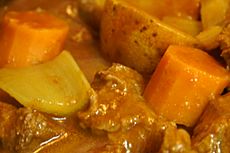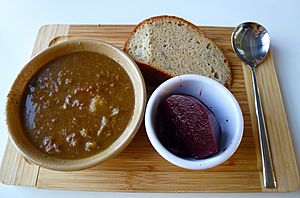Scouse (food) facts for kids
 |
|
| Type | Stew |
|---|---|
| Region or state | Northern Europe |
| Main ingredients | Beef or lamb, root vegetables |
Scouse is a tasty stew, usually made with pieces of meat, like beef or lamb. It also has vegetables such as potatoes and onions. This hearty dish is very popular in the city of Liverpool, England. People from Liverpool are often called "scousers" because of this stew!
The name "Scouse" comes from an older word, lobscouse. This was a stew that sailors ate a lot in northern Europe long ago. Different versions of lobscouse are still eaten in some countries today.
What is Scouse?
Scouse is a famous dish from the port city of Liverpool. There isn't one exact recipe for scouse. People traditionally made it with whatever leftover food they had. They also used vegetables that were in season.
Scouse is similar to other stews like Irish stew. However, scouse usually uses beef instead of lamb. The most important ingredients are potatoes, carrots, onions, and chunks of meat. Beef is often preferred over lamb. These ingredients are cooked together slowly for several hours.
Sometimes, the meat is cooked a little first. Then, some of the potatoes are boiled until they break apart. This helps to make the stew thick. After that, the meat and the rest of the potatoes are added. The stew then finishes cooking.
Many cooks also add a stock cube for more flavor. Some people like to add peas, lentils, or sweet potato. Herbs like rosemary, parsley, and basil can also be used.
Some people believe only beef, potatoes, carrots, and onions make real scouse. But others say that because it was a cheap dish, it could include "whatever vegetables you had." It would also use "the cheapest cuts of meat."
A version without meat is called "blind scouse." This was made for vegetarians. It was also made when people were too poor to buy meat. Scouse is usually served with pickled red cabbage or beetroot. It often comes with crusty bread too.
History of Scouse
Scouse has a strong connection to Liverpool and the area around it. Potatoes became popular in Lancashire (near Liverpool) in the late 1600s. By the late 1700s, potato-based lobscouse was a traditional dish. It was also known simply as scouse.
In 1797, someone described the dish. They said potatoes were "scraped raw" and chopped. They were then boiled with small pieces of meat. This mixture was made into a hash with pepper, salt, and onions. It was a cheap and healthy meal.
In the poorest parts of Liverpool, people sometimes couldn't afford meat. That's when they would make "blind scouse" using only vegetables.
The Oxford English Dictionary says "scouse" is a shorter version of "lobscouse." Lobscouse was a dish eaten by sailors in the 1700s. Similar stews are traditional in countries around the North Sea. These include Norway (lapskaus), Sweden (Lapskojs), and northern Germany (Labskaus).
However, these dishes are different from each other. They are also different from the original lobscouse. For example, Swedish Lapskojs and Norwegian Lapskaus are stews like scouse. But German Labskaus is more like a hash.
Old lobscouse was also different from today's scouse. It was more like a thick porridge. Sailors in the 1800s made it by boiling salted meat, onions, and pepper. They used ship's biscuit to make it thicker.
Global Scouse Day
In 2008, the first "Global Scouse Day" was held. It is now an annual event every February 28. On this day, bars, cafes, and restaurants in Liverpool and around the world serve scouse. They also raise money for charities.
Other Similar Dishes
Lobscouse is also remembered in other parts of northwest England. In the Potteries, a similar stew is called "Lobby." People from Leigh, Greater Manchester, are even called "lobby-gobblers." In North Wales, the full name is still used as "Lobscaws" (Welsh: lapsgóws).
A version of scouse has also been known in Newfoundland and Labrador, Canada. It has been there since at least 1792. It is described as a sea dish. It contains minced and salted beef, crumbled sea biscuit, potatoes, and onions.
See also
 In Spanish: Scouse (comida) para niños
In Spanish: Scouse (comida) para niños


